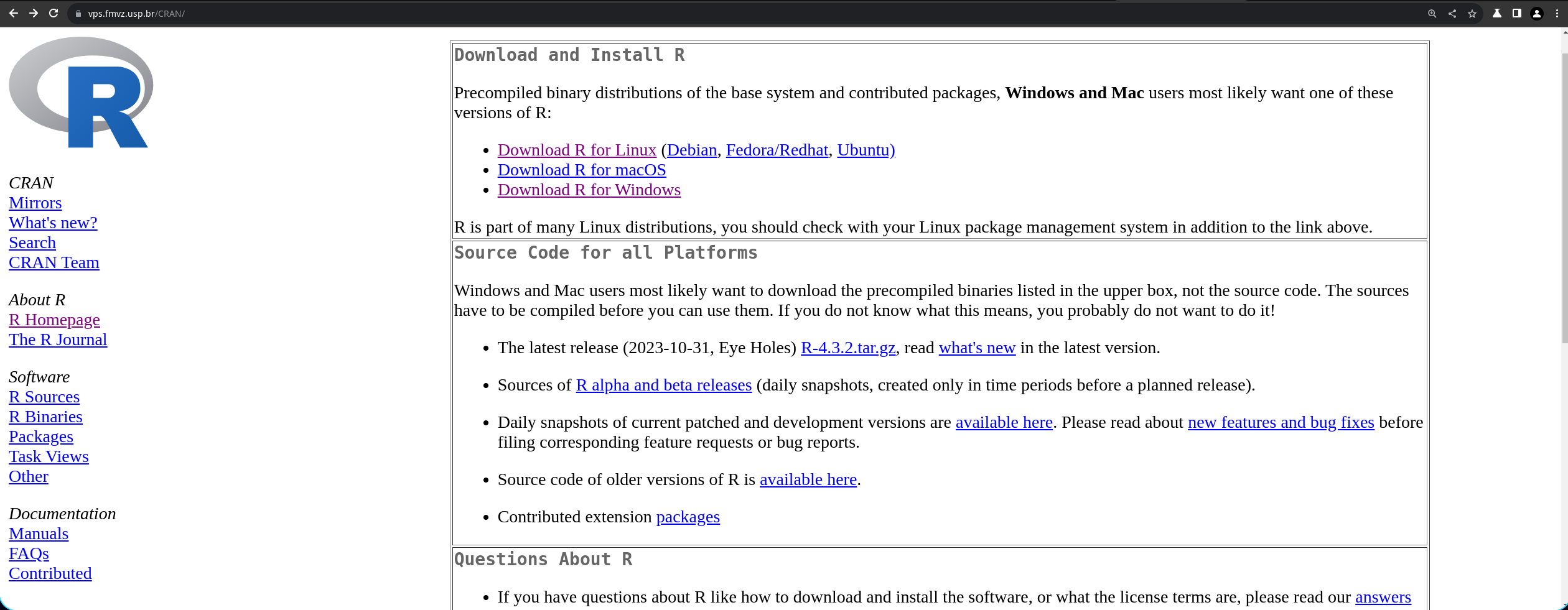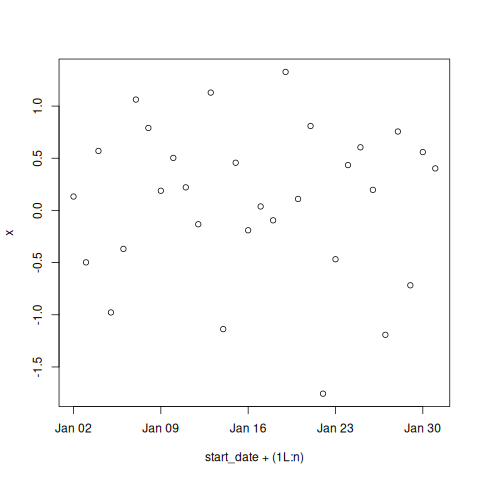Servidores locais:
- https://cran-r.c3sl.ufpr.br/ Universidade Federal do Parana
- https://cran.fiocruz.br/ Oswaldo Cruz Foundation, Rio de Janeiro
- https://vps.fmvz.usp.br/CRAN/ University of Sao Paulo, Sao Paulo
- https://brieger.esalq.usp.br/CRAN/ University of Sao Paulo, Piracicaba
sudo apt install -f ~/Downloads/rstudio-2023.09.1-494-amd64.debAbrir executável
C:\Downloads\rstudio-2023.09.1-494.exe
- https://code.visualstudio.com/docs/languages/r
- https://marketplace.visualstudio.com/items?itemName=REditorSupport.r
- https://github.com/randy3k/radian
- https://github.com/nx10/httpgd
In VS Code Quick Open (Ctrl+P):
ext install REditorSupport.r
- ess
- ess-R-data-view
- polymode
- poly-R
- company-stan
- eldoc-stan
- flycheck-stan
- stan-mode
(use-package ess)
(use-package ess-R-data-view)
(use-package polymode)
(use-package poly-R)
(use-package company-stan)
(use-package eldoc-stan)
(use-package flycheck-stan)
(use-package stan-mode)R is a dynamic language for statistical computing that combines lazy functional features and object-oriented programming.
This rather unlikely linguistic cocktail would probably never have been prepared by computer scientists, yet the language has become surprisingly popular.
- Tipação fraca.
- O.O. suporta tipação.
- Escopação léxica dinâmica.
- Aspectos Funcionais, como
lazy loading,pippingemaps. - Linguagem interpretada (vai bem em
scripts). - Rápida
- Utiliza línguas low-level,
C,Fortranunder the hood.
- Utiliza línguas low-level,
- Suporta
imperatividade.
Rotinas Imperativas
weight <- 85
size <- 1.84
(BMI <- weight/size^2)### Definition of an object BMI
setClass("BMI", representation(weight="numeric", size="numeric"))setMethod("show", "BMI",
function(object){cat("BMI =",object@weight/(object@size^2)," \n ")}
)### Creation of an object for me, and posting of my BMI
(myBMI <- new("BMI",weight=85,size=1.84))
### Creation of an object for her, and posting of her BMI
(herBMI <- new("BMI",weight=62,size=1.60))### Traditional programming, no type
(weight <- "Hello")
## Using classes
new("BMI",weight="Hello",size=1.84)
Objetos com métodos implícitos, como ___init___, em Python:
class Person:
def __init__(self, name, age):
self.name = name
self.age = age
p1 = Person("John", 36)
print(p1.name)
print(p1.age)(let [person {:name "John" :age 36}]
;; supérfulo criar um alias:
;; p1 person
(do
(println (:name person))
(println (:age person))))
;; (f x y)
;; (let binds body)
;; (+ 1 2)
(let [person {:name "John" :age 36}
show (fn [obj] (str (:name obj) " " (:age obj)))]
;; supérfulo criar um alias:
;; p1 person
;; (:name person)
;; (:age person))
(show person))package main
import (
"fmt"
"strconv"
)
type Person struct {
name string
age int
}
func (p Person) show() string {
return p.name + " " + strconv.Itoa(p.age)
}
func main() {
//creating struct specifying field names
p1 := Person{
name: "Fulano",
age: 20,
}
//creating struct without specifying field names
p2 := Person{"Ciclano", 37}
// "show" method
fmt.Println(p1.show())
fmt.Println(p2.show())
}Some languages, like
PerlandCommon Lisp, allow the programmer to choose static or dynamic scope when defining or redefining a variable.Examples of languages that use dynamic scope include
Logo,Emacs Lisp,LaTeXand the shell languagesbash,dash, andPowerShell.
- Local Escoping
(let ((a 1)
(b 2))
(+ a b))- Implicit Local Escoping
(defun f (a b)
(+ a b))
(f 1 2)(defclass book ()
((title :reader title
:initarg :title)
(author :reader author
:initarg :author))
(:documentation "Describes a book."))
(defmethod show ((b1 book))
(let ((titulo (title b1))
(autor (author b1)))
(print (format T "~S, ~S" titulo autor))))
(defparameter b1 (make-instance 'book
:title "ANSI Common Lisp"
:author "Paul Graham"))(show b1)require(grDevices)setClass(
Class="Trajectories",
representation=representation(
times = "numeric",
traj = "matrix"
)
)setMethod(
f= "plot",
signature= "Trajectories",
definition=function (x,y,...){
matplot(x=x@times,
y=t(x@traj), ## (x, y) coordenates
xaxt="n",
type="l",
ylab= "",
xlab="",
pch=1 ## plot specification
)
axis(1,at=x@times)
}
)trajPitie <- new(Class="Trajectories")
trajCochin <- new(
Class= "Trajectories",
times=c(1,3,4,5),
traj=rbind (
c(15,15.1, 15.2, 15.2),
c(16,15.9, 16,16.4),
c(15.2, NA, 15.3, 15.3),
c(15.7, 15.6, 15.8, 16)
)
)
trajStAnne <- new(
Class= "Trajectories",
times=c(1: 10, (6: 16) *2),
traj=rbind(
matrix (seq (16,19, length=21), ncol=21, nrow=50, byrow=TRUE),
matrix (seq (15.8, 18, length=21), ncol=21, nrow=30, byrow=TRUE)
)+rnorm(21*80,0,0.2)
)
par(mfrow=c (1,2))
plot(trajCochin)
plot(trajStAnne)R é uma linguagem interpretada.
Nome do arquivo: r-script
#!/usr/bin/r
require(grDevices)
options(echo=TRUE) # if you want see commands in output file
args <- commandArgs(trailingOnly = TRUE)
print(args)
# trailingOnly=TRUE means that only your arguments are returned, check:
# print(commandArgs(trailingOnly=FALSE))
start_date <- as.Date(args[1])
name <- args[2]
n <- as.integer(args[3])
rm(args)
# Some computations:
x <- rnorm(n)
png(paste(name,".png",sep=""))
plot(start_date+(1L:n), x)
dev.off()
summary(x)Rscript $(command -v r-script) 2023-01-01 "Deltrano" 30R:
- https://www.r-project.org/about.html
- https://en.wikipedia.org/wiki/R_(programming_language)
- https://link.springer.com/chapter/10.1007/978-3-642-31057-7_6
- https://www.r-bloggers.com/2013/06/practicing-static-typing-in-r-prime-directive-on-trusting-our-functions-with-object-oriented-programming/
- https://www.r-bloggers.com/2020/06/r-objects-s-objects-and-lexical-scoping/
- https://cran.r-project.org/doc/contrib/Genolini-S4tutorialV0-5en.pdf
Common Lisp:
- https://courses.cs.northwestern.edu/325/readings/clos.html

